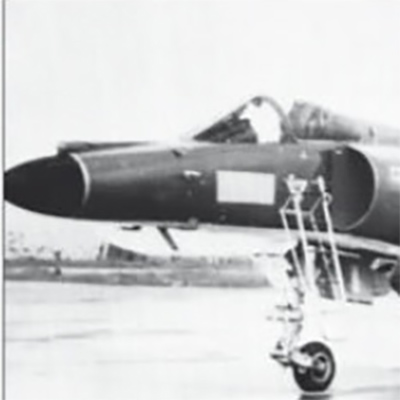Warfare
Super Étendard
Written by: Mohsen Shirmuhammad,
Translated by: Hadi Qorbanyar
74 دورہ
The Super Étendard is a French-made fighter aircraft that the Iraqi Air Force used during the Iran–Iraq War to target Iranian naval vessels.
The aircraft was developed in France in 1974 as a single-seat strike fighter capable of conducting operations at low and medium altitudes. Super Étendard is equipped with systems for engaging naval targets and features in-flight refueling capability. The Super Étendard has a wingspan of 9.6 meters, a length of 14.30 meters, and a height of 3.86 meters. It can carry up to 2,100 kilograms of armament, reach a top speed of 1,230 km/h, and operate at altitudes up to 13,700 meters.[1]
The aircraft is equipped with a CSF Agave radar with a range of 120 miles, capable of locking onto targets from 100 miles away. It continuously transmits target data to the Exocet missile’s onboard memory until the weapon reaches approximately 8 miles from the target. Equipped with advanced electronic warfare systems, the Super Étendard can carry one Exocet missile and four 400-kg bombs.[2] In addition to its two 30mm cannons,[3] it has both in-flight refueling and fuel-dispensing capability, and is capable of carrying air-to-air missiles.[4]
During its invasion of Iran, Iraq sought to purchase ten Super Étendard aircraft from France, but Paris agreed only to lease five.[5] Therefore, ten Iraqi pilots underwent a three-month flight training course in France. Moreover, fifteen foreign technicians—seven French and eight Belgian—went to Iraq to undertake maintenance and prepare the aircraft for service.[6] The jets were delivered to Iraq in October 1983, and it took about four months before they became fully operational.[7]
In their first operational mission, Iraqi Super Étendards mistakenly struck the FILIKON, a Greek oil tanker carrying 80,000 tons of Kuwaiti crude, south of Kharg Island.[8] On December 3, 1984, in a joint operation with Mirage F1s, they targeted a Cypriot tanker (transporting Iranian export oil) about 40 miles southwest of Bushehr.[9]
Super Étendards usually flew in pairs to protect each other from Iranian fighter aircraft.[10] The radar installed on these jets lacked accurate target identification and recognition capabilities, which resulted in multiple misfires and the loss of missiles against unintended targets.[11]
In its final recorded operation on December 21, 1984, a Super Étendard attacked and sank the Magnolia, a Liberian-flagged tanker carrying Iranian crude oil, 31 miles south of Kharg Island.[12] Eventually, in late 1984, four of the Super Étendards were returned to France[13] of which one crashed into the sea due to poor pilot visibility, killing the pilot.[14] The aircraft were later replaced in Iraqi Air Force by Mirage F1 fighters.[15]
[1] Shervin, Kourosh, Super Etendard, Selahi Jari va Talash-e Mazboohane-ye Digar (Super Étendard: A Bold Weapon and Another Desperate Attempt), Mahname-ye Saf, No. 48, Azar 1362, p. 49.
[2] Lotfollahzadegan, Ali-Reza va Eraj Hemmati, Roozshomar-e Jang-e Iran va Araq, Ketab-e Bisto Hashtom: Nokhostin Amaliyat-e Bozorg dar Shomal-e Gharb – Valfajr 4 (Chronology of the Iran–Iraq War, Book 28: The First Major Operation in the Northwest – Valfajr 4), Tehran: Markaz-e Asnad va Tahqiqat-e Defa Muqaddas-e Sepah-e Pasdaran-e Enqelab-e Eslami, 1396, Pp. 338–339.
[3] Ibid., p. 339.
[4] Ibid.
[5] Ibid.
[6] Ibid., p. 338.
[7] Zargar, Aghil, Sarab, Dastan-e Mirazh-haye Araqi: Bakhsh-e Dovvom (Mirage Illusion: The Story of Iraqi Mirages – Part II), Mahname-ye Sanaye-e Havaei, No. 220, Mehr 1388, p. 5.
[8] Anthony Cordesman va Abraham Wagner, Dars-haye Jang-e Modern: Jang-e Iran va Araq (Lessons of Modern War: The Iran–Iraq War), Vol. 2, trans. Hussain Yekta, Tehran: Nashr-e Marz-o-Boom, 1st ed., 1390, p. 502.
[9] Zargar, Aghil, Ibid., p. 5.
[10] Navias, Martin S. va E.R. Hooton, Jang-e Naftkesh-ha (The Tanker War), trans. Pezhman Pourjabbari and Rahmat Qareh, Tehran: Bonyad-e Hefz-e Aasar va Nashr-e Arzesh-haye Defa Muqaddas, 1392), p. 169.
[11] Cordesman, Anthony va Abraham Wagner, Ibid., p. 509.
[12] Zargar, Aghil, Ibid., p. 5.
[13] Navias, Martin S. va E.R. Hooton, Ibid., p. 208.
[14] M. Woods, Kevin va Digaran, Jang-e Iran va Araq az Didgah-e Farmandehan-e Saddam (The Iran–Iraq War from the Perspective of Saddam’s Commanders), trans. Abdolmajid Heidari, Tehran: Nashr-e Marz-o-Boom, 1393, p. 351.
[15] Cordesman, Anthony va Abraham Wagner, Ibid., p. 403.



